| . |  |
. |
Stockholm (AFP) Nov 30, 2009 The Swedish capital Stockholm registered only 17.5 hours of sunshine for the entire month of November, making it the gloomiest November since 2000, meteorologists said Monday. The sun shone on average for only 35 minutes a day during the month, the Swedish Meteorological and Hydrological Institute (SMHI) said. In the past quarter-century, only the years 2000 and 1993 had darker months of November, with eight and nine hours of golden rays respectively, while the average for the month is 54 hours. Because clouds trap heat and prevent clear skies and crisp temperatures, November 2009 was also one of the warmest Novembers in 25 years. The average temperature in Stockholm was 5.6 degrees Celsius (42 Fahrenheit), compared to an average of 2.9 degrees over the past 25 years. Only the year 2000 was warmer at 7.0 degrees. Stockholm, one of the northernmost capitals in the world, also has less sunshine in November because of the shorter daylight period, with around seven hours of daylight in November. By contrast Sweden has long sunny days during the summer months, on average 292 hours of sunshine in June and 260 hours in July. Share This Article With Planet Earth
Related Links Weather News at TerraDaily.com
 NASA Researchers Explore Lightning's NOx-ious Impact On Pollution, Climate
NASA Researchers Explore Lightning's NOx-ious Impact On Pollution, ClimateGreenbelt MD (SPX) Oct 28, 2009 Every year, scientists learn something new about the inner workings of lightning. With satellites, they have discovered that more than 1.2 billion lightning flashes occur around the world every year. (Rwanda has the most flashes per square kilometer, while flashes are rare in polar regions.) Laboratory and field experiments have revealed that the core of some lightning bolts reaches 30,000 ... read more |
|
| The content herein, unless otherwise known to be public domain, are Copyright 1995-2009 - SpaceDaily. AFP and UPI Wire Stories are copyright Agence France-Presse and United Press International. ESA Portal Reports are copyright European Space Agency. All NASA sourced material is public domain. Additional copyrights may apply in whole or part to other bona fide parties. Advertising does not imply endorsement,agreement or approval of any opinions, statements or information provided by SpaceDaily on any Web page published or hosted by SpaceDaily. Privacy Statement |